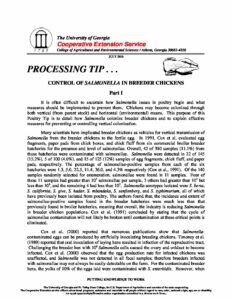It is often difficult to ascertain how Salmonella issues in poultry begin and what measures should be implemented to prevent them. Chickens may become colonized through both vertical (from parent stock) and horizontal (environmental) means. This purpose of this Poultry Tip is to detail how Salmonella colonize breeder chickens and to explain effective measures for preventing or controlling vertical colonization. Many scientists have implicated breeder chickens as vehicles for vertical transmissio...n of Salmonella from the breeder chickens to the fertile egg. In 1991, Cox et al. evaluated egg fragments, paper pads from chick boxes, and chick fluff from six commercial broiler breeder hatcheries for the presence and level of salmonellae. Overall, 42 of 380 samples (11.1%) from those hatcheries were contaminated with salmonellae. Salmonella were detected in 22 of 145 (15.2%), 5 of 100 (4.6%), and 15 of 125 (12%) samples of egg fragments, chick fluff, and paper pads, respectively. The percentage of salmonellae-positive samples from each of the six hatcheries were 1.3, 5.0, 22.5, 11.4, 36.0, and 4.3% respectively (Cox et al., 1991). Of the 140 samples randomly selected for enumeration, salmonellae were found in 11 samples. Four of these 11 samples had greater than 103 salmonellae per sample, 3 others had greater than 102 but less than 103, and the remaining 4 had less than 102. Salmonella serotypes isolated were S. berta, S. california, S. give, S. hadar, S. mbandaka, S. senftenberg, and S. typhimurium, all of which have previously been isolated from poultry. The authors found that, the incidence and extent of salmonellae-positive samples found in the breeder hatcheries were much less than that previously found in broiler hatcheries, meaning that overall, the industry is reducing Salmonella in breeder chicken populations. Cox et al. (1991) concluded by stating that the cycle of salmonellae contamination will not likely be broken until contamination at these critical points is eliminated.
ATTACHMENTS
Details
| Year | Volume | Number | Categories |
|---|---|---|---|
| 2010 | 50 | 9 |

